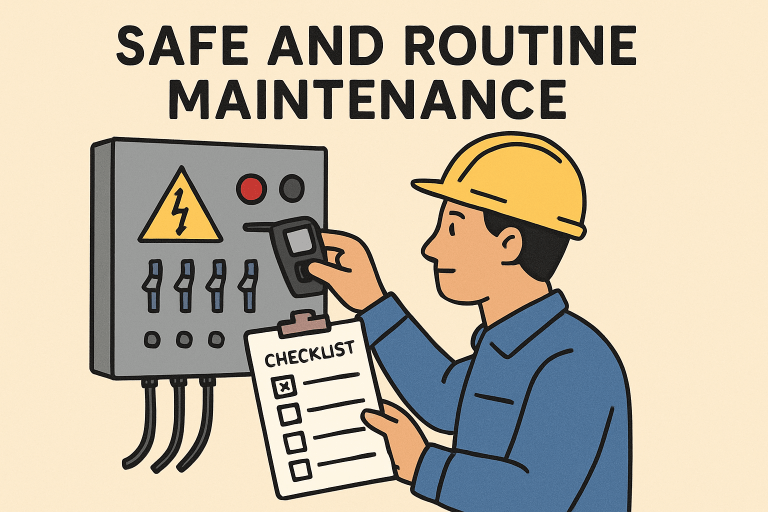How Routine Maintenance Prolongs the Lifespan of Electrical Equipment

Electrical equipment is crucial for industrial, commercial, and residential environments, powering manufacturing lines, providing comfort, and supporting essential services. Regular maintenance is essential for optimal performance and safety.
Table of Contents
Prioritizing preventative care can prevent costly breakdowns and productivity disruptions and protect the well-being of all in the facility. For businesses seeking comprehensive protection and longevity for their assets, expert electrical equipment testing and refurbishing services are invaluable, ensuring critical assets operate at their best for years to come. Click here for more.
Regular maintenance of electrical equipment systems is crucial to prevent sudden failures, significant repair costs, and regulatory violations. Comprehensive maintenance strategies help identify deteriorating components, signs of overheating, and wear-and-tear issues before they escalate into serious problems. This proactive approach reduces the risk of expensive emergencies and ensures that compliance with safety codes and insurance requirements is an ingrained part of operations.
Importance of Regular Maintenance
A complex network of electrical systems is at the core of any modern building or facility. These systems are responsible for functioning every essential service—from powering machines on a manufacturing floor to keeping security and data infrastructure running smoothly.
When electrical equipment systems are overlooked, even the most robust infrastructure becomes susceptible to inefficiency, erratic operation, or catastrophic failure, which disrupts business continuity and poses serious health and safety risks.
Seemingly minor issues, such as undetected insulation damage or subtle component degradation, may silently escalate until they cause fires, equipment loss, or hazardous working conditions. The consequences range from expensive shutdowns to life-threatening emergencies for building occupants.
The need for maintenance is strongly emphasized in standards published by the National Fire Protection Association (NFPA). The NFPA 70B standard provides specific protocols and methodologies for inspecting, servicing, and documenting actions taken on electrical systems, especially in commercial and industrial environments.
Adhering to these best practices isn’t merely about satisfying regulatory boxes—it’s about minimizing threats like equipment failure and electrical fires.
Regular physical checkups help detect emerging health issues early, and scheduled electrical inspections and maintenance help facilities run optimally, minimize hazards, and retain reliability across the whole lifespan of their equipment.
Benefits of Routine Maintenance
Routine maintenance is crucial for maintaining electrical equipment, as it helps prevent hazards such as overheated wires, degraded insulation, and overloaded circuits. This proactive approach reduces the risk of electrical incidents, ensuring compliance with OSHA standards and the well-being of employees, contractors, and visitors.
Regular maintenance increases energy efficiency by reducing unnecessary resistance or inefficiencies, leading to cost savings and a smaller carbon footprint. Regular interventions, such as lubricating moving parts, controlling corrosion, and replacing aging relays, extend the usable life of each asset, protecting the return on capital investment.
Compliance with electrical and safety standards can be challenging, but companies that produce thorough documentation of routine services establish themselves as responsible operators, avoiding fines, litigation, or shutdowns. This commitment enhances the company’s professional image with customers, insurers, and regulatory bodies.
Implementing an Effective Maintenance Program
Establishing a truly effective maintenance regime requires nuanced planning, structured implementation, and unwavering follow-through. Begin by cataloging every significant electrical component in your facility. Record its age, manufacturer guidelines, previous service history, and operational role, identifying which pieces are most critical to production and safety.
Next, set up a recurring schedule using a detailed calendar, considering periods of high usage, expected wear, environmental factors (like humidity or dust), and regulatory and industry standards guidance. This foundational step ensures maintenance is not merely reactive but systematically aligned with your facility’s unique risk landscape.
- Assessment: Start by thoroughly evaluating all electrical assets, identifying their current state, pinpointing any existing deficiencies, and prioritizing critical systems that could cause the most disruption if they failed.
- Scheduling: Develop a robust calendar that incorporates recommendations from manufacturers, industry standards, and usage patterns, while also considering production cycles, seasonal demands, and anticipated peak loads.
- Documentation: Keep detailed records for every service, inspection, repair, and replacement performed. These logs provide a reference for troubleshooting and continuous improvement and are crucial for demonstrating compliance during regulatory or insurance reviews.
- Training: Equip all personnel involved in maintenance with up-to-date training on safe practices, evolving technologies, and regulatory requirements. A commitment to skill development ensures that maintenance is performed efficiently, safely, and to the highest industry standards.
Modern technologies are revolutionizing maintenance practices. Predictive maintenance tools—featuring sensors, real-time analytics, and machine learning—collect and analyze performance data to preemptively identify when equipment may be at risk of failure, sometimes long before any outward symptoms appear.
These systems enable targeted interventions, reduce unnecessary routine checks, and ultimately lower maintenance costs while maximizing equipment uptime. Companies integrating predictive maintenance enjoy greater transparency, fewer surprises, and improved operational performance.
If a facility faces complex equipment issues, needs advanced diagnostics, or seeks to modernize older systems, it is wise to contact professionals.
Harnessing the experience of experts—such as those who provide specialized electrical equipment testing and refurbishing services—ensures accurate assessments, precise repairs, and rejuvenation of aging systems, extending their productive life and reliability.
See also: From the Initial Draft to the Final Edit, Rely on Trinka Grammar Checker
Conclusion
Routine maintenance is far more than an operational duty—it’s a cornerstone of lasting safety, efficiency, and success for any organization that depends on electrical equipment.
By creating and rigorously following a detailed maintenance plan, facilities guard against the unexpected, extend the usable life of their assets, and sustain peak operational performance.
Leveraging expert services, well-chosen technological solutions, and an unwavering focus on training and recordkeeping puts organizations in the strongest position to thrive. Invest in routine maintenance today, and you’ll lay the groundwork for safer, more innovative, and more resilient operations tomorrow.



